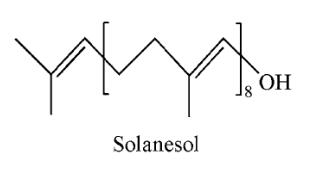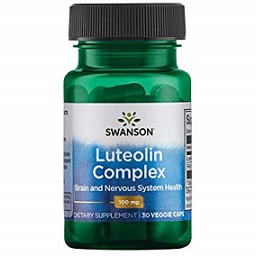Solanesol: a versatile long-chain polyisoprenoid alcohol compound
Solanesol possesses antimicrobial, anti-tumor, anti-inflammatory, and anti-ulcer activities, and it serves as an important pharmaceutical intermediate for the synthesis of coenzyme Q10, vitamin K2, and N-solanesyl-N,N′-bis(3,4-dimethoxybenzyl) ethylenediamine (SDB).
Solanesol is a long-chain polyisoprenoid alcohol compound with nine isoprene units. It mainly accumulates in solanaceous crops, including tobacco, tomato, potato, eggplant, and pepper plants. As the chemical synthesis of solanesol is dfficult due to its long carbon chains [1], solanesol is mainly obtained through extraction from solanaceous plants. To the best of our knowledge, tobacco is the richest plant source of solanesol. Among the various organs of tobacco plants, leaves possess the highest content of solanesol, followed by stems and roots. Therefore, tobacco leaves have been regarded as the ideal material for solanesol extraction. Tobacco, an economic crop widely planted in the world, which has marked medical value because of its rich content of solanesol and other beneficial active ingredients. Moreover, the extraction technology and determination methods of solanesol are the basis for further research, development, and application [2].
Solanesol is a secondary metabolite. Various plants produce numerous highly-specific terpenoids that play important roles in plant–environment interactions. In tobacco, solanesol might participate in the immune response towards pathogens: in a 2017 study by Bajda et al., the solanesol content in resistant tobacco varieties increased by more than 7 times one week after infection by the tobacco mosaic virus (TMV), while it did not increase significantly after infection in susceptible varieties. In potato, as compared to normal temperatures (22 °C during the day, 16 °C at night), moderately high temperatures (30 °C during the day, 20 °C at night) caused a more than six-fold increase in the solanesol content after one week, indicating that solanesol might play an important role in the response of potato to moderately high temperatures. Hence, solanesol plays important roles in the interactions of solanaceous plants with environmental factors [3].

Pure solanesol is a waxy white solid at room temperature, nonpolar or weakly polar, optically inactive, insoluble in water, slightly soluble in methanol and ethanol, and easily soluble in hexane, chloroform, and acetone (Liu 2010). In plants, solanesol exists in both free and esterified forms, and its accumulation is influenced by genetic and environmental factors.
Since the discovery of solanesol in tobacco by Rowland et al., significant progress has been achieved in research on its bioactivities, medicinal value, biosynthesis, extraction technology and determination methods. Resaerches have proven that solanesol possesses antioxidant, anti-inflammatory, neuroprotective, and antimicrobial activities. Solanesol possesses strong free radical absorption ability and antioxidant activity owing to the presence of several non-conjugated double bonds. Notably, Solanesol is widely used in the pharmaceutical industry as an intermediate for the synthesis of ubiquinone drugs, such as coenzyme Q10, vitamin K2 and the anticancer agent synergiser N-solanesyl-N,N’-bis(3,4-dimethoxybenzyl) ethylenediamine (SDB). Solanesol derivative micelles have been used in the delivery of hydrophobic drugs. Solanesol derivatives can also be used for the treatment of cardiovascular disease, osteoporosis, acquired immune deficiency syndrome, and wound healing [4].
References
[1] S.J. Roe, M.F. Oldfield, N. Geach, A. Baxter, A convergent stereocontrolled synthesis of [3-14C] solanesol, J. Label. Compound. Radiopharm., 2013, 56, 485–491.
[2] N.Yan, Y. H. Liu, L. Q. Liu, Y. M. Du, X. M Liu, H. B. Zhang, Z. F. Zhang, Bioactivities and Medicinal Value of Solanesol and Its Accumulation, Extraction Technology, and Determination Methods, Biomolecules, 2019, 9, 334.
[3] https://en.wikipedia.org/wiki/Solanesol
[4] N.Yan, Y. H. Liu, L. Q. Liu, Y. M. Du, X. M Liu, H. B. Zhang, Z. F. Zhang, Solanesol: a review of its resources, derivatives, bioactivities, medicinal applications, and biosynthesis, Phytochem Rev., DOI 10.1007/s11101-015-9393-5.
You may like
See also
Lastest Price from Solanesol manufacturers

US $0.00/mg2023-02-24
- CAS:
- 13190-97-1
- Min. Order:
- 5mg
- Purity:
- ≥98%(HPLC)
- Supply Ability:
- 10 g

US $15.00-10.00/KG2021-07-02
- CAS:
- 13190-97-1
- Min. Order:
- 1KG
- Purity:
- 99%+ HPLC
- Supply Ability:
- Monthly supply of 1 ton


